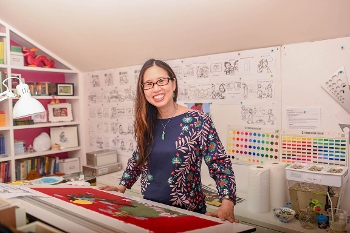Grace Lin Discusses Carle Museum Exhibit and Kennedy Center Disappointment
A career retrospective at The Eric Carle Museum of Picture Book Art and the current political climate have kid lit creator Grace Lin considering the purpose of her future work.
For children’s book creator Grace Lin, it has been a summer of dreams—one realized and one denied, or at the very least deferred.
In June, The Eric Carle Museum of Picture Book Art opened a retrospective of her work, “The Art of Grace Lin: Meeting a Friend in an Unexpected Place.”
“I know how dedicated they are to children's books [and] children's picture book art; how important it  is to them and what care they put into their exhibits,” Lin says. “So when they asked me if I wanted to be one of their featured artists and have an exhibit, I was just so moved and touched and honored. It's a real special thing to have an exhibit there.”
is to them and what care they put into their exhibits,” Lin says. “So when they asked me if I wanted to be one of their featured artists and have an exhibit, I was just so moved and touched and honored. It's a real special thing to have an exhibit there.”
Then in August, she received an email from the John F. Kennedy Center for the Performing Arts, where her books Chinese Menu and A Big Bed for Little Snow were in development to become stage productions. The email stated that the Kennedy Center was undergoing significant institutional change and cuts to its Theater for Young Audiences budget and staff, and would not be moving forward with developing Chinese Menu, according to Lin.
“This was another dream come true that did not come true for me,” she says.
Back in Amherst, MA, the Carle’s walls walk visitors through Lin’s decades of work.
“It's kind of like going to your own funeral,” Lin says with a laugh. “My whole life is up on the walls.”
The presentation allowed her to view her work and the purpose in it in a way that she hadn’t considered before.
“When I look at the retrospective, I can see how the purpose in my work has changed,” says Lin, who earned a Newbery Honor for Where the Mountain Meets the Moon in 2010 and a Caldecott Honor for A Big Mooncake for Little Star in 2019. “I always feel like purpose is such a really important thing you need to have as a children's book creator.”
The early years were dominated by the need to fill a void in the children’s publishing industry.
“The first portion of my career, I really felt strongly about getting Asian American culture, Asian American faces, into children's literature,” she says.
The early works cover topics such as Lunar New Year and Chinese festivals. But as kid lit became more diverse and simply having Asian American representation in a book was not as urgent an issue, she put more of her creative self Into the work and focused on “making beautiful books,” she says.
“I can see how that purpose changed,” she adds. “I’m not sure exactly where it changed, but I can see [it] when I see from the beginning to where I am now.”
Where it goes from here is another question. Lin’s work will always center Asian American characters and culture, she says, but the current political climate may change the trajectory and return her more to her earlier motivation.
“As I saw my work in the latter part of the show, I was beginning to think I could create books where the characters just happened to be Asian and their presence was not necessarily subversive—like the character in Once Upon a Book," Lin says. "However, with the current political climate, I realize any non-white character is seen as confrontational, and I will again—as I always have—need to see my work as part-activism and not as pure artistic expression."
The Kennedy Center cancellation drove home, for her, the current anti-diversity climate, even if she can’t say for sure that it contributed to the project ending. Chinese Menu had been in development for a couple of years since Lin first approached the team at the Washington, DC, arts center about pursuing an adaptation. A theater lover, she knows the impact a live performance can have and the importance of such an iconic location.
“A performance is such a visceral, all-encompassing feeling,” she says. “A book is one thing, but [the show] would reach so many more people, and it would reach them in a different way, in a much more accessible way. I thought the Kennedy Center, because of it being the Kennedy Center in Washington, DC—this American landmark—it would mean even more.”
Lin was going to be paired with an experienced playwright provided by the Kennedy Center to help develop the script and adapt her stories. She may seek a new place to move forward with a possible stage production, but right now is about regrouping, she says.
“The Kennedy Center was the perfect venue,” she says. “With that gone, it feels really, really sad.”
RELATED
The job outlook in 2030: Librarians will be in demand
The job outlook in 2030: Librarians will be in demand
ALREADY A SUBSCRIBER? LOG IN
We are currently offering this content for free. Sign up now to activate your personal profile, where you can save articles for future viewing






Add Comment :-
Be the first reader to comment.
Comment Policy:
Comment should not be empty !!!